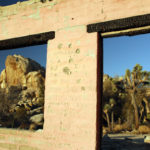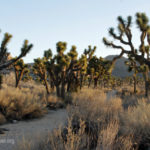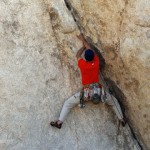
Joshua Tree National Park is different from many other prominent national parks because its attractions are more subtle and its size is so vast (794,000 acres). At first I wasn’t too excited by the desert expanse that featured an endless brown terrain dotted with joshua trees and scattered rocks. Keeping an open mind, I soon discovered why the park is so popular and we ended up enjoying our visit very much. Dark night skies, gnarly joshua trees, unusual rock formations and the sight of rock climbers clinging to vertical rock faces, all make this a place worth seeing.
MAIN ATTRACTIONS:
- Rock climbing, or watching people doing rock climbing
- Hiking (the park guide lists 12 Nature Trails and 6 Hiking Trails)
- Camping in wonderfully situated campsites among rock formations
- Mountain biking
- Star gazing
- Photography

WHERE TO STAY: There are nine campgrounds in the park. If you want to stay during weekends when it’s not too hot, you’d better reserve a campsite–I noticed that every campground we saw was full. Call 1-877-444-6777 up to six months in advance to make campsite reservations. I would try hard to find a space along the main Park Boulevard loop where most of the main attractions are located. We did not camp, but I noted that the campground at Hidden Valley was really great with good spacing between sites that were tucked among the big boulders; Jumbo Rocks offered a great setting but many of the 125 sites were jammed together– tranquil desert silence would not be the reason to camp there; Ryan is in a good location near everything. We stayed in the Twentynine Palms’ Best Western Garden Hotel, which worked out well as a convenient location to the park, and some surprisingly good restaurants. Check out the hotel at http://bestwesterngardens.com/ or call 760-367-9141.
WHAT TO DO:


HIKING: During our two days at the park, we did four hikes:
Hidden Valley: This one mile loop was so enjoyable that I felt it made the whole trip worthwhile. Don’t miss this little jewel of a hike that undulates through varied rock formations and valleys; every few minutes there was another scene worth photographing.
Ryan Mountain: A three mile roundtrip up to a 5458 foot summit with a full panoramic view; it was, as advertised, moderately strenuous and took us, at a leisurely pace, about 2.5 hours.
Barker Dam: I hurried up this one mile loop trail for sunrise photography and this wasn’t the place for it (too buried between surrounding hills). After a half mile or so, I reached a dried lake bed, so I turned back. I wasn’t excited by the trail, but it might well deserve more time and a better time of day later than 6am. However….there was another trail nearby that headed east from the same parking lot, and that was a great place for sunrise shots and an appreciation of the plants, rock formations and human history in this location. I passed through a joshua tree lined section of the trail and soon discovered a picturesque, broken down house set among the boulders and cholla cacti. Nearby was an old, rusty truck. I enjoyed photographing this area and would have liked to spend more time following the trail up into the hills where signs indicated there was some sort of old mill.
Jumbo Rocks: We arrived here before sunset and hiked among the boulders and the campsites. It is a scenic spot that provides a decent sunset view and an accumulation of large boulders to explore; the main drawback was the large number of campsites tucked among the rocks but still too close together for my liking.

OTHER THINGS TO SEE:
KEYS VIEW: This is a 20 minute drive from Park Blvd down Keys View Road. It offers a panoramic view of the Coachella Valley and is a recommended place to visit and take photos.
CHOLLA CACTUS GARDEN: While this place was closed due to road repairs, years ago I remember hiking through this wickedly attractive cholla cactus garden with my young son and I would highly recommend a visit. But just in case you aren’t aware of how mean and nasty the cholla cactus thorns are, just let me say this: if you have the misfortune of getting a set of cholla cactus thorns stuck in your skin, you will require pliers to pull them out (I’m not kidding; my sister found this out the hard way once….). So tread carefully and watch the kids, but enjoy the savage beauty.
FLOWERS: If viewing the spring desert wildflowers is your goal, check out the offical park wildflower status site: http://www.nps.gov/jotr/planyourvisit/blooms.htm. We were there in late March and saw no flowers, sadly.
KEYS RANCH SIGHTSEEING TIP: I would like to have toured Keys Ranch where a family successfully homesteaded in the park for many years, but I discovered you cannot see this interesting place without an official park tour guide (fine is $75 if you try visit on your own). Make reservations ahead of time by calling 760-367-5555. Looks worthwhile–do this.
GETTING TO THE PARK: This Mojave Desert park is 140 miles east of Los Angeles, 145 miles northeast of San Diego and 215 miles southwest of Las Vegas. You will enter the park either from the south, via Cottonwood Spring (7 miles from the 10 Freeway), or from the north, via either the Joshua Tree/ West Entrance Station (45 miles from the 10 Freeway) or the Twentynine Palms / North Entrance Station (63 miles).
MORE INFORMATION TO PLAN YOUR TRIP:
Website: www.nps.gov/jotr.
Park Address:
Joshua Tree National Park
74485 National Park Dr.
Twentynine Palms, CA 92277-3597
760-367-5500
Campground reservations: Call 877-444-6777 up to six months in advance
























































































